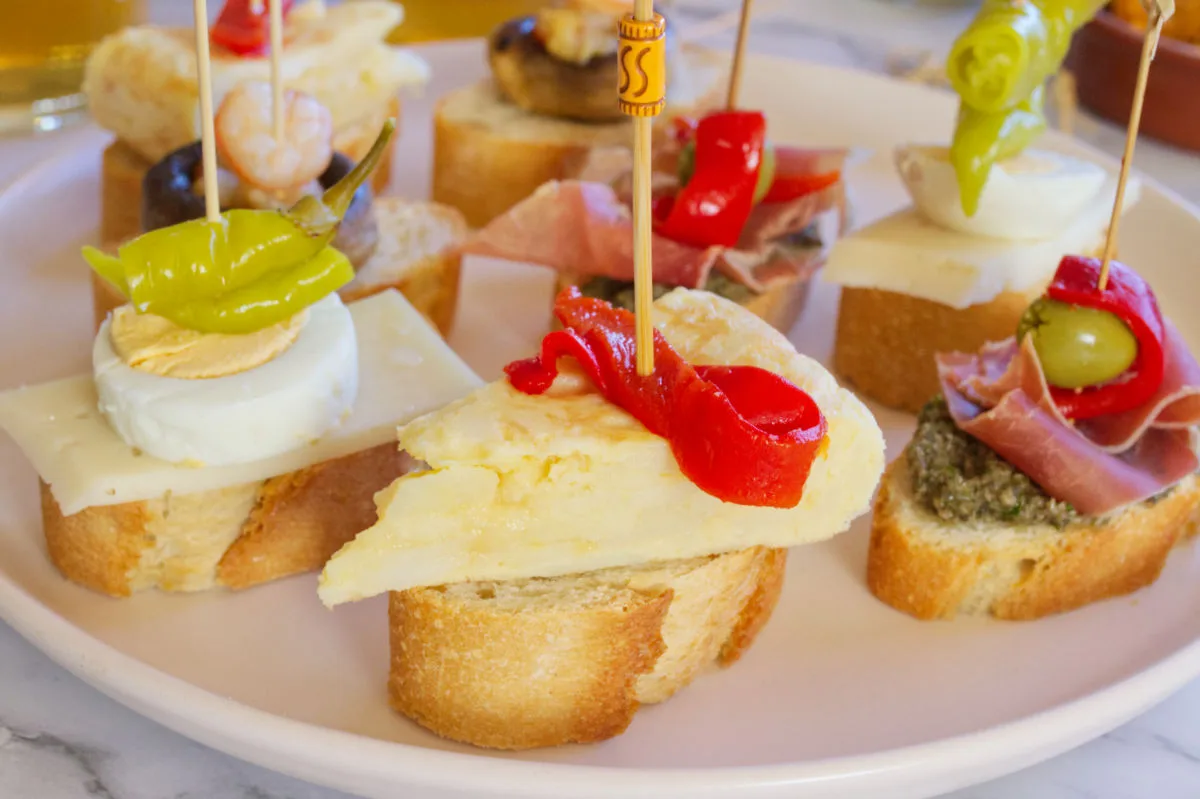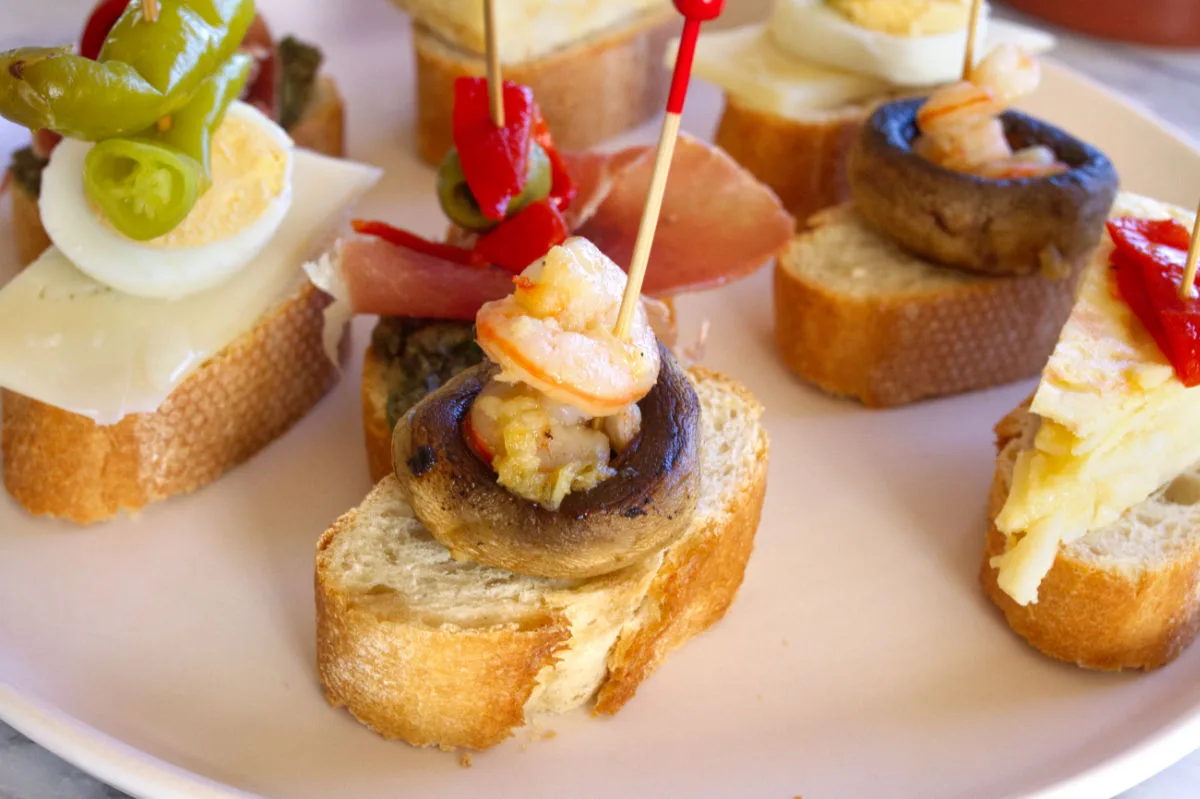If you’ve been to the Basque Country (Euskadi) in Spain, then you would have had pintxos (that’s a 99.99% certainty rate). Just about any bar you wander into will have pintxos on display.
Similar, but not the same as tapas, the idea is you snack as you drink. Pintxos are individual servings and are part of a very social way of enjoying a drink and bar-hopping to sample different foods with your friends or family.
Table of contents:
What are Spanish Pintxos (Pinchos)?
Originating from the Spanish word “pinchar,” meaning to pierce or spike, pintxos were initially simple skewered items served in bars. They were typically bite-sized but now range in sizes and some are nearly full-blown sandwich-sized.
Pintxos is how the word is written in the Basque language, Euskara, whereas ‘pinchos’ is used in Spanish. You’ll see both used interchangeably and they mean exactly the same thing: little treasures of deliciousness.
The Evolution of Pintxos
Pintxos have evolved from humble skewers to intricate, flavorful, and tasty morsels, that are often visual masterpieces. The tradition has expanded beyond the Basque region, becoming an integral part of Spanish cuisine. But you won’t find them in every bar in Spain. If you want to go to Spain and try the pintxos culture out, then apart from the Basque Country, other regions that have adopted pintxos are La Rioja, Navarra, and Cantabria.
While most pintxos still have a toothpick or skewer involved, not all do anymore. Modern pintxos bars often go beyond the conventional traditions and can get very creative. In these establishments, pintxos have become a canvas for chefs to showcase their skills and experiment with unique combinations — and entice people passing by to pop in for one…and perhaps stay for an entire meal.
Common Flavors and Combinations
Pintxos come in a wide array of flavors, reflecting the abundance of fresh and locally sourced ingredients available in Spain. From succulent seafood to cured meats, marinated vegetables, and artisan cheeses, the combinations are endless.

Since pintxos often rely on so few ingredients, what sets them apart is the meticulous attention to ingredients and presentation. This means freshness is key, so when you’re making these at home keep this in mind. Beautifully laid out pintxos are also important as they help you enjoy the whole experience more, with all the senses.
Some classic pintxos varieties include the Gilda (anchovies, olives, and pickled Guindilla peppers), Jamón con Huevo de Codorniz (ham with quail egg), and Montadito de Chorizo (chorizo on bread).
The most well-known pintxos in Spain is the Gilda. It’s a type of banderilla pintxos, which simply refers to a small snack served on a stick or toothpick. The Gilda was created in San Sebastian, which is no surprise at all as this city is the undisputed birthplace of pintxos. Today, you will find the Gilda in many parts of Spain and it even comes served in some drinks like vermouth if you order a glass out.
Which Drinks to Serve with Pintxos?
This is really dependent on what pintxos you choose. As we just mentioned, the Gilda often comes served inside a glass of vermouth. Spanish vermouth is sweet and often served in a glass with ice and normally with no mixer. In some parts, a Gilda comes on the side or in the drink. They’re a perfect pairing since the Gilda is so savory and the vermouth so sweet.
Other drinks that are common to find in pintxos bars are beer, cider, and local wines. It all comes down to your preference and trying to match the best pintxos to your drink, or vice versa.
How to Make Pintxos at Home
OK, there’s no exact science to this and you really can let your imagination run free and be as creative as you like! Just remember freshness and presentation will be your friends here.
We’re going to give you some ideas of what ingredients to include and mix and match in your pintxos. These are commonly used in Spain so a good place to start if you want to recreate an authentic (or as close to as possible) night in a Basque bar from the comfort of your home. These are also great for parties since they’re the perfect finger food.

One of the best things about pintxos is how versatile they are. If you’re short on time, throw some no-cook ingredients onto a toothpick (pickled red pepper, cheese, olive). If you want to make something more lavish, then fry up some shrimp and mushrooms with olive oil or butter and place them on a slice of baguette with a toothpick holding it together.
Common Ingredients for Pintxos
| Ingredient | Vegan | Vegetarian | Seafood | Meat |
| Pickled red peppers (capsicum) | ✔️ | |||
| Pickled Guindilla peppers | ✔️ | |||
| Padron peppers | ✔️ | |||
| Olives | ✔️ | |||
| Caramelized onion | ✔️ | |||
| Mushrooms | ✔️ | |||
| Cheese | ✔️ | |||
| Hard-boiled egg | ✔️ | |||
| Aioli | ✔️ | |||
| Tortilla (potato omelet) | ✔️ | |||
| Boquerones in vinegar | ✔️ | |||
| Anchovies | ✔️ | |||
| Cooked shrimp | ✔️ | |||
| Glass eels (elvers) | ✔️ | |||
| Spider crab | ✔️ | |||
| Imitation crab meat | ✔️ | |||
| Spanish cured ham | ✔️ | |||
| Chorizo pieces | ✔️ | |||
| Morcilla (blood sausage) | ✔️ | |||
| Bacon | ✔️ |
You can also buy fancier skewers or even bamboo sticks to make your pintxos even more visually appealing. Many are reusable, so you can just wash these when you’re done and save them for your next pintxos party or night in.
¡Buen provecho amigos!


Leave a Reply